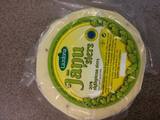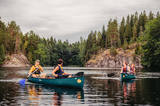| Nr | Name | Beschreibung |
|---|---|---|
|
"Ziedlejas" offers sauna treatments and events in the contemporary design Glass Sauna, Smīma Spruce Smoke Sauna and Black Sauna, which is located in an unspoilt corner of the forest. The ritual sauna treatment includes heating, herbal compresses, herbal scrub, big beating, swimming in the pond, massage with healing oil and honey, vibrating with sound, tea, home-baked bread. The sauna treatment lasts four to five hours and is led by a sauna master. Various master classes are possible in connection with sauna rituals and the use of plants in healing and beauty care and the preparation of appropriate preparations. Bicycle rental is available, which includes access to the Ziedleju xc / enduro trails, bicycle training and bicycle guide services. It is also possible to organize and lead team building events, as well as team communication trainings. |
||
|
The cafe is situated in the guest house Zitari on the first floor, in the town of Roja, alongside the road, 500 m away from the sea. |
||
|
The "Baltic Way" route is in honour of a unique demonstration on August 23, 1989, when residents of the three Baltic States joined hands in a chain of participants that stretched along a nearly 600 km distance to link the three capital cities of Vilnius, Rīga and Tallinn. In historical terms, this route was used from the 14th or 15th century or even earlier than that. Grain-based foods in this region have a long history. Tasty and yeasty rye bread is common, and in Vidzeme, try it with some hemp butter. Barley is used to bake buns and for porridges. Wheat is used to bake water pretzels with caraway seeds. Visit farms and restored windmills to track the route of grain. A special cheese is part of Summer Solstice celebrations, and on a daily basis you can enjoy other tasty cheeses made of cow and goat milk. Various river and lake fishes are popular, as are local meat and fowl dishes and wild game with tasty sauces. A roast or a pot of soup cooked on a live campfire will have a lovely aroma, and it will be served with vegetables, greens, beans, peas and mushrooms. Wild plants such as sorrel, dandelion or young nettle leaves are added to soups and salads. Treat yourself with fresh honey, bacon pies, sheet cakes, pastries, rye bread desserts, honey cakes and gingerbread. You will find simple and traditional dishes, romantic meals in castles and estates, as well as a special knighthood repast with spices typical in the age of the Livonian Order. Slake your thirst with herbal teas, birch juice, berry beverages, tasty beer or wine or a glass of something stronger. |
||
|
Auffällig sind die beiden 60m hohen Türme des im Barockstil erbauten Gotteshaus. Die Kanzel, der Orgelprospekt, die Orgel und ein Beichtstuhl stammen aus dem 18. Jh., die Seitenaltäre vom Beginn des 19. Jh. Im zentralen Teil des Altars befindet sich das Gemälde „Die wundertätige Gottesmutter von Aglona aus dem 17.Jh., dem Heilkräfte zugesagt werden, daher wird es nur zu bedeutenden Zeiten gezeigt. Vor dem Besuch des römischen Papstes Johannes Paul II in Lettland im Jahre 1993 fanden umfangreiche Renovierungs- und Umbauarbeiten am Kirchenkomplex statt. Alljährlich kommen am 15. August Pilger nach Aglona, um das Fest Mariä Himmelfahrt zu feiern. Etwa 100m von der Basilika befindet sich die heilige Quelle Aglonas Svētavots. |
||
|
Das Unternehmen stellt Milch, Quark und Quarkprodukte, Joghurt, Desserts her. Für die Herstellung der Erzeugnisse wird Milch von hoher Qualität verwendet. Die Milch wird von mehr als 100 bäuerlichen Betrieben und 3 Kooperativen geliefert. Alle Produktionsprozesse werden eingehalten und verbessert für die Verbesserung des Geschmacks und Erhöhung des Nährwertes der Produktion. Betriebsbesichtigung und Verkostung. Eines der fünf lettischen Unternehmen, das den weichen Kümmelkäse "Jāņu" herstellen darf, der als garantiert traditionelle Spezialiät in das EU-Register eingetragen ist. Die Erzeugnisse haben das Qualitätszeichen „Grüner Löffel” erhalten. |
||
|
Um eine Einführung in die Arbeiten der lettischen Handwerker zu bekommen, besuchen Sie das Ethnographische Freilichtmuseum in Riga, wo Ihnen geschickte Meister die traditionellen Handwerke zeigen werden. Außerhalb Riga besuchen Sie ein Unternehmen, das Birkensäfte und aus denen ach Weine herstellt. Hier erfahren und sehen Sie, wie der Birkensaft gewonnen und aufbewahrt wird. Sie können diese Produkte auch verkosten. Weiter führt die Tour zu einem Gebiet, das mit historischen Legenden verbunden ist. Sie besuchen das Museum des bekannten lettischen Helden Lacplesis (Bärenreißer), um den Lielvarde-Gürtel zu sehen, in dem mit alten, geheimen Symbolen die Geschichte geschrieben ist. In Koknese können Sie mit einem Wikingerboot um die malerischen Ruinen der Burg von Koknese fahren. Danach besuchen Sie einen Hof, wo Hanf angebaut und traditionelle Hanfbutter hergestellt wird, sowie einen Ziegenhof und einen Hersteller, der hausgemachtes traditionelles Bier braut. Die Region Latgale ist mit ihrer Gemeinschaft "Töpferschule" und der "schwarzen" Keramik bekannt. Unterwegs besuchen Sie einige Werkstätte, sowie das Zentrum der Handwerker von Ludza, das eine ausgezeichnete Einsicht in die lokalen Traditionen gibt. Auf einem der Region Latgale typischen Hof können Sie das lettische Saunaritual und eine Mahlzeit probieren, die dieser Gegend charakteristisch ist. Weiter führt die Tour zu der Basilika von Aglona, die ein Wallfahrtsziel ist. Um den Magen zu erfreuen, besuchen Sie das Brotmuseum, einen Hof, der köstliche Käse und andere gesunde Milchprodukte herstellt, und einen Hersteller von Kräutertees, der Ihnen einige gesunde Tipps geben kann. Sie besichtigen das historische Zentrum der Stadt Daugavpils, die eindrucksvolle Festung aus dem 19. Jh. und eine Fabrik, wo Bleischroten hergestellt werden und wo sich der größte Schrotturm von Europa befindet, der immer noch arbeitet. Auf dem Rückweg nach Riga besuchen Sie die eindrucksvolle Perle des Baltikums – das Schloss von Rundale. |
||
|
Atrodas Numerenes dabas parka teritorijā. 20 m augstais tornis uzbūvēts uz t.s. Numerenes vaļņa, no kura paveras plaša ainava un aizaugošām lauksaimniecības zemēm un nelielu mitrāju ar Kugreņa ezeru austrumu virzienā. Torņa apkaimē izveidota izziņas taka. |
||
|
Within easy reach of the Finnish capital of Helsinki, visitors can escape into wild natural settings and enjoy typically Finnish scenery, with lovely lakes, green forests and rugged crags. The nearby Finnish Nature Centre Haltia spotlights the best of Finland's natural treasures from across the country. |
||
|
Um In der Altstadt von Cēsis ein warmes Brot zu bekommen, kann man nicht nur den Anweisungen, sondern auch dem verlockenden Brotgeruch folgen, das durch den Bogen direkt zur Bäckerei führt. Das Brot wird aus den in Lettland biologisch angebauten Körnern gebacken, es wird mit natürlichem Sauerteig hergestellt. Brotverkostung, Erzählung über die Zutaten, Gärung und Backen eines gesunden Brotes. |
||
|
Dabas parkā izveidota Baltijā vienīgā Bišu taka, kurā apmeklētājs var iejusties bites ‘’lomā’’. Zinātkārie var ieģērbties bitenieka tērpā un novērot bišu dzīvi stropā vai kāpt kokā ar seno dravnieka ierīci – dzeini. Ekskursija, Bišu, Putnu, Meža, Sporta un Augu takas. |
||
|
Einer der seltenen Orte, wo eine kleine Gruppe (2 bis 3 Personen) sich in einem Fischerboot auf die See begeben und den Küstenfischfang beobachten kann. In Zusammenarbeit mit anderen Fischern wird diese Möglichkeit auch an größeren Gruppen angeboten. Der auf dem Fluss Svētupe gebaute Neunaugen-Fischzaun unterscheidet sich in seinem Aufbau und in der Art des Fischfangs von den Fischzäunen auf dem Fluss Salaca. |
||
|
Ein mannigfaltiger Waldbestand, der durch die Vidzemer Straße und die Eisenbahnlinie Rīga-Lugaži halbiert ist. Das ist das Gebiet, in dem der am meisten gefährdete Vogel der Welt – die Blauracke – gefunden wird. Zwischen ¼ und 1/5 des lettischen Bestandes an Krähen findet man hier. Es ist auch eines der letzten Nistgebiete des Grünspechtes.
|
||
|
Auf dem Pfad der Volkskunde werden altlettische Zeichen, Symbole und Volkslieder (lett. Dainas) erklärt. Hier kann man viel Interessantes über die Bedeutung von Pflanzen für unsere Gesundheit erfahren, Lieder singen, Reigen spielen und lettische Rituale für alle wichtigsten Feiern des Lebens (Taufe, Hochzeit u.a.) bestellen, sowie an Feuer- und Saunaritualen und dem Feiern von traditionellen lettischen Festen teilnehmen. Mit vorheriger Anmeldung kann man traditionelle Mahlzeiten verkosten. |
||
|
Traditionelle Spielzeuge von verschiedenen historischen Perioden und Völkern. |
||
|
Atrodas Jūrmalciema austrumdaļā. Koka šķūnī sakrāti vietējo entuziastu savāktie Jūrmalciema iedzīvotāju sadzīves priekšmeti un amata rīki. Novadpētnieki te var uzzināt vērtīgu informāciju par ciema vēsturi un zvejnieku dzīvesveidu. |
||
|
Spieķu darbnīca Siguldā aicina izdzīvot spieķa izgatavošanas procesu, kam ir vairāk kā 200 gadu sena vēsture. Darbnīcā ir iespējams pašiem apgleznot savu spieķīti, vai iededzināt rakstu zīmes un vārdus. Spieķīši ir atpazīstamākais un senākais Siguldas simbols, kas attīstījies līdz ar kņaza Kropotkina ierīkotajām senlejas takām, kļūstot par gājēja neatņemamu ceļabiedru. |
||
|
Atrodas pilsētas centrā - Tirgus laukuma malā. Dievnams tapis 1495. g., pēc Livonijas ordeņa mestra Valtera fon Pletenberga (~ 1450. – 1535.) pavēles. Gadsimtiem ritot, ēka pārbūvēta un tagad redzamais tornis celts 1907. g. Baznīcā apskatāmi nozīmīgi kultūrvēstures pieminekļi: altārglezna “Golgāta” - H. Kīperta darināta kopija (pēc K. Arnoldi Kandavas luterāņu baznīcas oriģināla (1864. g.)), muižniekam Fīlipam Drahenfelsam veltīta epitāfija (B. Bodekers, 16. un 17. gs. mija), A. D. Tīzenhauzenas kapu plāksne (1648. g.), kristāmtrauka pamatne (18. gs.) un piemiņas plāksne 1. pasaules karā un Latvijas Brīvības cīņās kritušajiem draudzes locekļiem (1925. g.). Ap Tirgus laukumu (atjaunots, jauka strūklaka) izvietojies Dobeles vēsturiskais centrs. |
||
|
The Cheese hut dates back to 1768 and was once part of the Kalnamuiža (Smiltene) Estate. It is the only object of industrial heritage that is still found in Latvia. On the first floor there was the storage of milk and a set of cheese pots. Stairs to the second floor have been lost. The second floor was used to dry cheese, and the process was facilitated by holes in the walls of the hut so that the wind could help in the process. Although the holes have been filled up, their placement can still be easily seen. The Cheese hut is alongside the ruins of the Medieval castle in Smiltene. Sadly, it is in terrible shape and can only be viewed from the outside. |
||
|
This farm has been offering cheese for 20 years, with milk coming from its own dairy cows. The farm sells cheese at major markets and fairs in Latvia. |
||
|
A marked hiking route (a guide will be needed) begins at the Jēči windmill, which was built in 1878. Nearby is a dendrology park and a collection of rocks. You will learn about moraines and other geological features in the region, study various kinds of swamps, see the unique piles of rock at Pugas, as well as the Kraujiņi rock. The route is 7 or 5 km in length, returning at the starting point, and it will take some four hours to traverse. Be sure to put on waterproof boots!
|
||























